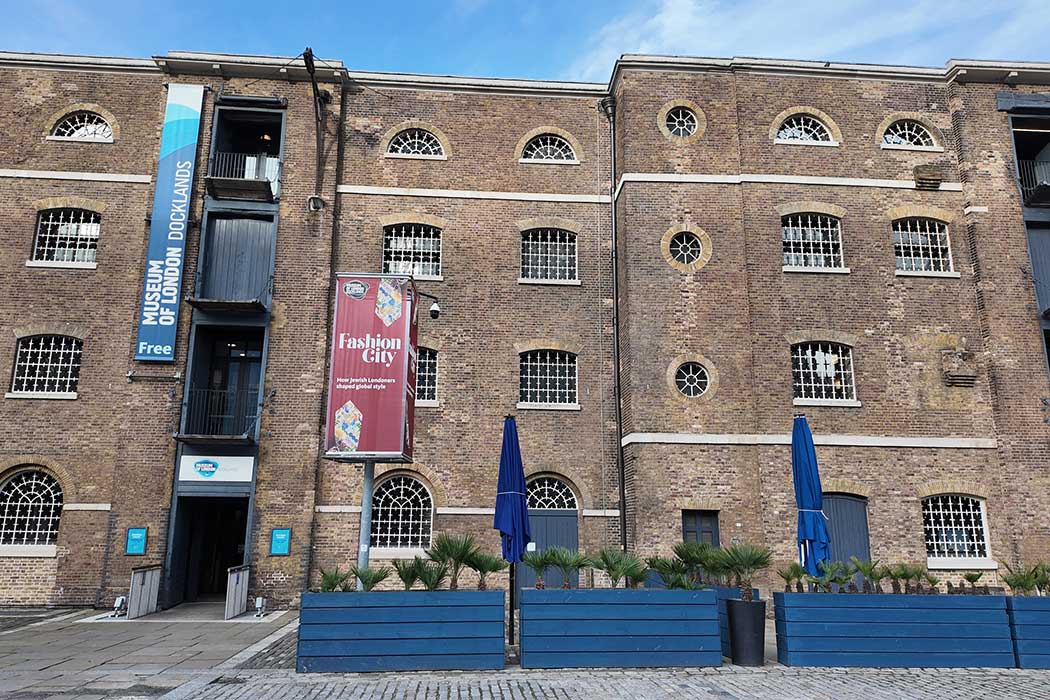London Museum Docklands (formerly Museum of London Docklands) is housed in a 19-century sugar warehouse just to the north of Canary Wharf. It has displays showing the importance of London’s docks and how this area of London has changed throughout history.

What to see at London Museum Docklands
The London Museum Docklands shows the development of London’s Docklands from Roman times to the present day.
The museum’s permanent galleries are arranged in chronological order and include:
Nº 1 Warehouse
Nº 1 Warehouse is the museum’s introductory gallery, which tells you about the building that the museum now occupies and also gives you an overview of how London’s docks operated in their heyday in the early 19th century.
Trade Expansion (1600–1800)
The Trade Expansion gallery illustrates the trade that passed through London’s docks during the 17th to 19th centuries including the silk, spice and tea trade from China and India.
London, Sugar & Slavery (1600–today)
The excellent London, Sugar & Slavery gallery shows the impact of the slave trade from the 17th century to the present day.
City and the River (1800–1840)
The City and River gallery shows the impact of changes to London’s port in the early 19th century when the docks were developed on the Isle of Dogs.
Sailortown (1840–1850)
This gallery shows what the neighbourhoods surrounding the docks, such as Shadwell and Wapping, where like in the mid-19th century.
First Port of Empire (1840–1880)
The First Port of Empire gallery depicts the Victorian empire when London’s docks grew in importance as the United Kingdom developed its global empire. Not only was this a time of increased international trade, it was also a time of rapid progress as wooden sailing ships were replaced by larger and faster iron steamers.
Warehouse of the World (1880–1939)
The Warehouse of the World gallery shows London’s docks during the period between 1880 and 1939 when London was the world’s busiest port.
Docklands at War (1939–1945)
This gallery shows the role of London’s docks during the Second World War. It shows the impact of air raids and the Docklands’ role in the war effort.
New Port, New City (1945–present)
With the advent of containerisation, London’s prominence as a port declined and the Docklands became Europe’s largest regeneration project with an ambitious programme of gentrification with new commercial and residential development.
The Port of Grimsby and Immingham is now United Kingdom’s largest port by cargo tonnage while Felixstowe and Southampton are the UK’s busiest container ports.
Mudlarks
Mudlarks is the museum’s children’s gallery. It is an interactive space designed for children up to eight years old.
Temporary exhibitions
This museum hosts a programme of temporary exhibitions in addition to its permanent displays. Current and planned exhibitions include:
Secrets of the Thames
This exhibition (until 1 March 2026) is the UK’s first major display dedicated to mudlarking. It features over 350 objects uncovered from the Thames foreshore, many shown for the first time. Items range from personal belongings to historical relics, reflecting London’s past. Visitors can learn how mudlarks identify and curate finds, and explore the role of tides and the moon in revealing these artefacts. The exhibition blends archaeology with contemporary art and digital media.
Visiting London Museum Docklands
London Museum Docklands is located in the Docklands near Canary Wharf. It is just a three-minute walk to West India Quay DLR station and a five-minute walk to the centre of Canary Wharf complex.
The museum is fully wheelchair accessible, although it is in a Georgian building with original floorboards that may be uneven in places.
The museum has a cafe and a bar/restaurant, Rum & Sugar, with a Caribbean-inspired menu and over 200 varieties of rum behind the bar.
Most visitors spend 2–3 hours in the museum.
We may earn a small commission if you book after clicking the links below.


There are no comments yet.